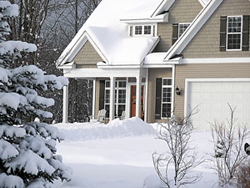It is never too early to winterize your home.
With Old Man Winter quickly approaching, now would be a great  time to get prepared,by taking certain steps and you can lessen the chances of a loss to your home due to inclement weather:
time to get prepared,by taking certain steps and you can lessen the chances of a loss to your home due to inclement weather:
- Verify that your furnace is in proper working order by contacting a heating specialist for an inspection. Heating device malfunctions, including those involving space heaters, are the second leading cause of fire deaths in the U.S. Also, most experts recommend vacuuming your heating ducts every five years.
- Check your plumbing system closely since burst water pipes can spew hundreds of gallons of water into your home. Use heat tape on any pipes exposed to extremely cold weather. Learn how to shut your water off to minimize damage from burst pipes.
- Replace any cracked or missing roof shingles and verify that flashing around the vent pipes or chimney is watertight. Roof too steep? Have a reputable contractor do the repairs for you. The cost to do so certainly would be less than the deductible under your homeowners policy should a loss occur.
How to avoid damage from an ice dam on your roof
Here’s how ice-damming becomes a problem
- Home heat rises and warms the roof underside, melting exterior snow and ice.
- Water running down the roof refreezes at the cold roof edge, building ridges to form an ice dam.
- Water can’t drain and accumulates, backing up and seeping below shingles, causing ceiling, insulation, and wall damage.
- Roof loading is further increased and can lead to collapse.
Here’s the solution
- Have your roof and gutter systems inspected regularly for tightness and drainage.
- Remove any debris or obstructing tree branches.
- Consider having additional insulation installed above ceilings or having roof vents upgraded to prevent warm air from rising to the roof.
- If problems persist, have roof heating cables installed.
Winter weather losses that might have been prevented
- At owner’s secondary home, he sets heat at 50 F, but because plumbing is located behind poorly insulated external wall, pipes burst due to extreme cold.
- Ice damming: Owner fails to clear debris from gutters, and melting snow backs up, freezes, then pushes water under shingles into home, causing severe water damage.
- Radiator pipes along non-insulated wall freeze and burst due to extreme cold and wind chill, causing basement to flood.
Source: Harleysville Risk Services
